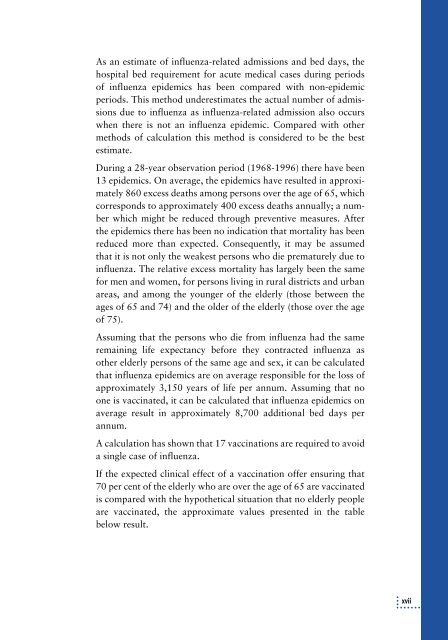Elektronisk udgave - Sundhedsstyrelsen
Elektronisk udgave - Sundhedsstyrelsen
Elektronisk udgave - Sundhedsstyrelsen
You also want an ePaper? Increase the reach of your titles
YUMPU automatically turns print PDFs into web optimized ePapers that Google loves.
As an estimate of influenza-related admissions and bed days, the<br />
hospital bed requirement for acute medical cases during periods<br />
of influenza epidemics has been compared with non-epidemic<br />
periods. This method underestimates the actual number of admissions<br />
due to influenza as influenza-related admission also occurs<br />
when there is not an influenza epidemic. Compared with other<br />
methods of calculation this method is considered to be the best<br />
estimate.<br />
During a 28-year observation period (1968-1996) there have been<br />
13 epidemics. On average, the epidemics have resulted in approximately<br />
860 excess deaths among persons over the age of 65, which<br />
corresponds to approximately 400 excess deaths annually; a number<br />
which might be reduced through preventive measures. After<br />
the epidemics there has been no indication that mortality has been<br />
reduced more than expected. Consequently, it may be assumed<br />
that it is not only the weakest persons who die prematurely due to<br />
influenza. The relative excess mortality has largely been the same<br />
for men and women, for persons living in rural districts and urban<br />
areas, and among the younger of the elderly (those between the<br />
ages of 65 and 74) and the older of the elderly (those over the age<br />
of 75).<br />
Assuming that the persons who die from influenza had the same<br />
remaining life expectancy before they contracted influenza as<br />
other elderly persons of the same age and sex, it can be calculated<br />
that influenza epidemics are on average responsible for the loss of<br />
approximately 3,150 years of life per annum. Assuming that no<br />
one is vaccinated, it can be calculated that influenza epidemics on<br />
average result in approximately 8,700 additional bed days per<br />
annum.<br />
A calculation has shown that 17 vaccinations are required to avoid<br />
a single case of influenza.<br />
If the expected clinical effect of a vaccination offer ensuring that<br />
70 per cent of the elderly who are over the age of 65 are vaccinated<br />
is compared with the hypothetical situation that no elderly people<br />
are vaccinated, the approximate values presented in the table<br />
below result.<br />
xvii

















